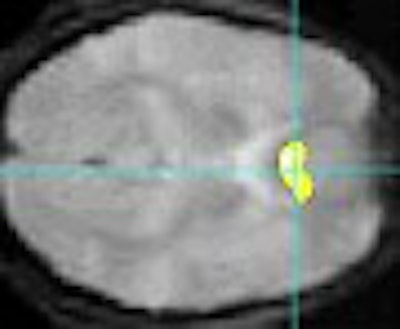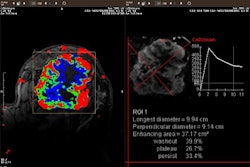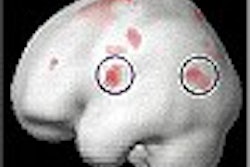
When your mother told you to always tell the truth so you won't have to keep track of the lies, she wasn’t kidding. A new functional MRI (fMRI) study has shown that different regions of the brain are engaged when separating fact from fiction, and that lying apparently takes more effort.
"MRI is a new potential technology (to detect deception) that could either be used with a polygraph or (could) perhaps stand on its own," said Dr. Scott Faro in an interview with AuntMinnie.com. Faro, who is the director of the MRI Research Laboratory at Drexel University Medical Center in Philadelphia, presented his group’s work at the 2003 meeting of the American Society of Neuroradiology in Washington, DC.
 |
When a study subject was covering up the truth, the anterior cingulate (above) and limbic lobe (below) were two areas in the brain that became active. Images courtesy of Dr. Scott Faro.
 |
In the study, three subjects discussed an event that only two of them had actually participated in: shooting a gun loaded with blanks into a pillow. The shooters were instructed to lie about what they’d done, but otherwise, tell the truth. All of the subjects were hooked up to a four-channel polygraph machine when they were questioned about the events by Nathan Gordon, a polygraph expert and the director of the Academy for Scientific Investigative Training in Philadelphia.
An event-related MR design was used for collecting the functional MR images. As expected, the polygraph picked up the liars, Faro said. But the fMRI scans showed significant differences in activation patterns when subjects were lying. Results showed the anterior cingulate, limbic lobe, and inferior frontal regions to be active during the deception process. However, when telling the truth, activation was predominantly seen in the temporal lobe and lentiform nuclei regions.
"We theorized that there are two major processes unique to truth and deception," Faro said. "One process has to do with judgment, planning, and inhibition, and the regions involved are the anterior cingulate, the dorsolateral prefrontal cortex, and the inferior frontal region. You have to judge the question, plan what the answer will be, and inhibit a (true) response," he said.
In contrast, telling the truth should require very little in the way of planning, judgment, or anxiety. This study bore out the theory to some extent, Faro said. One subject had only anterior cingulate activation when lying, while the other liar had both anterior cingulate and amygdala activity, Faro said. The amygdala are involved in fear and anxiety.
When the subjects were telling the truth, they didn’t have activation in those regions, he said.
"Truth-telling is a normal process. There’s no conflict or inhibition of response and emotional content," he said.
Faro cautioned that the study is "very preliminary, and we don’t really know we can make huge conclusions," he said. The researchers are now planning a larger study, involving 10 subjects, to see if they can replicate the results.
Faro added that it is unlikely there will be a single signature of falsehood that will apply to all people in all situations, but that a trend of patterns involving various regions of the brain will most likely emerge.
By Michael SmithAuntMinnie.com contributing writer
June 11, 2003
Related Reading
PET-sonography combination highlights memory differences in schizophrenics, June 2, 2003
Amnesiacs retain some memories, according to MR studies, April 4, 2003
fMRI reveals secrets of better memory, January 13, 2003
FDG-PET spies early decline in forgetful folks, October 22, 2002
Copyright © 2003 AuntMinnie.com


.fFmgij6Hin.png?auto=compress%2Cformat&fit=crop&h=100&q=70&w=100)





.fFmgij6Hin.png?auto=compress%2Cformat&fit=crop&h=167&q=70&w=250)











